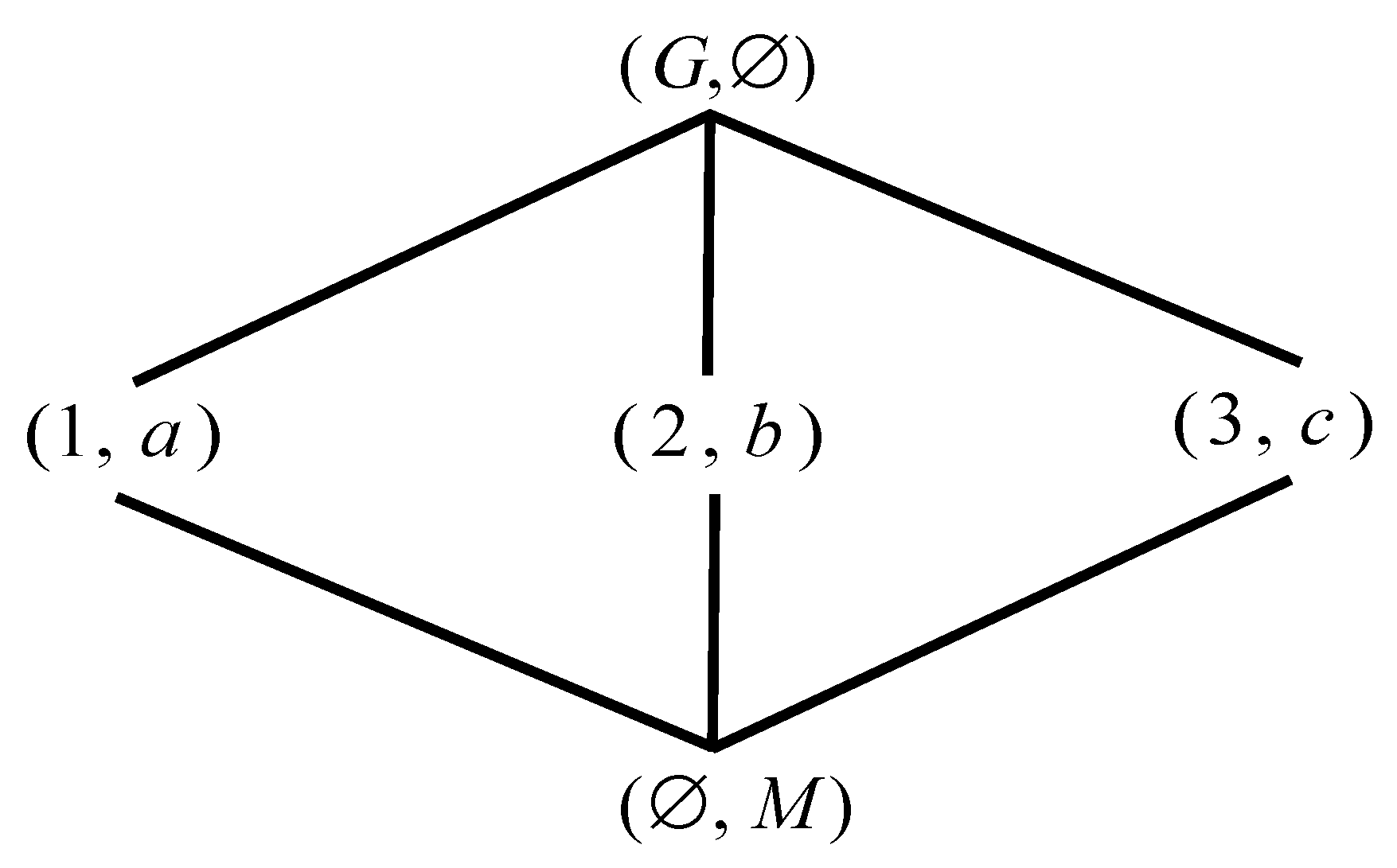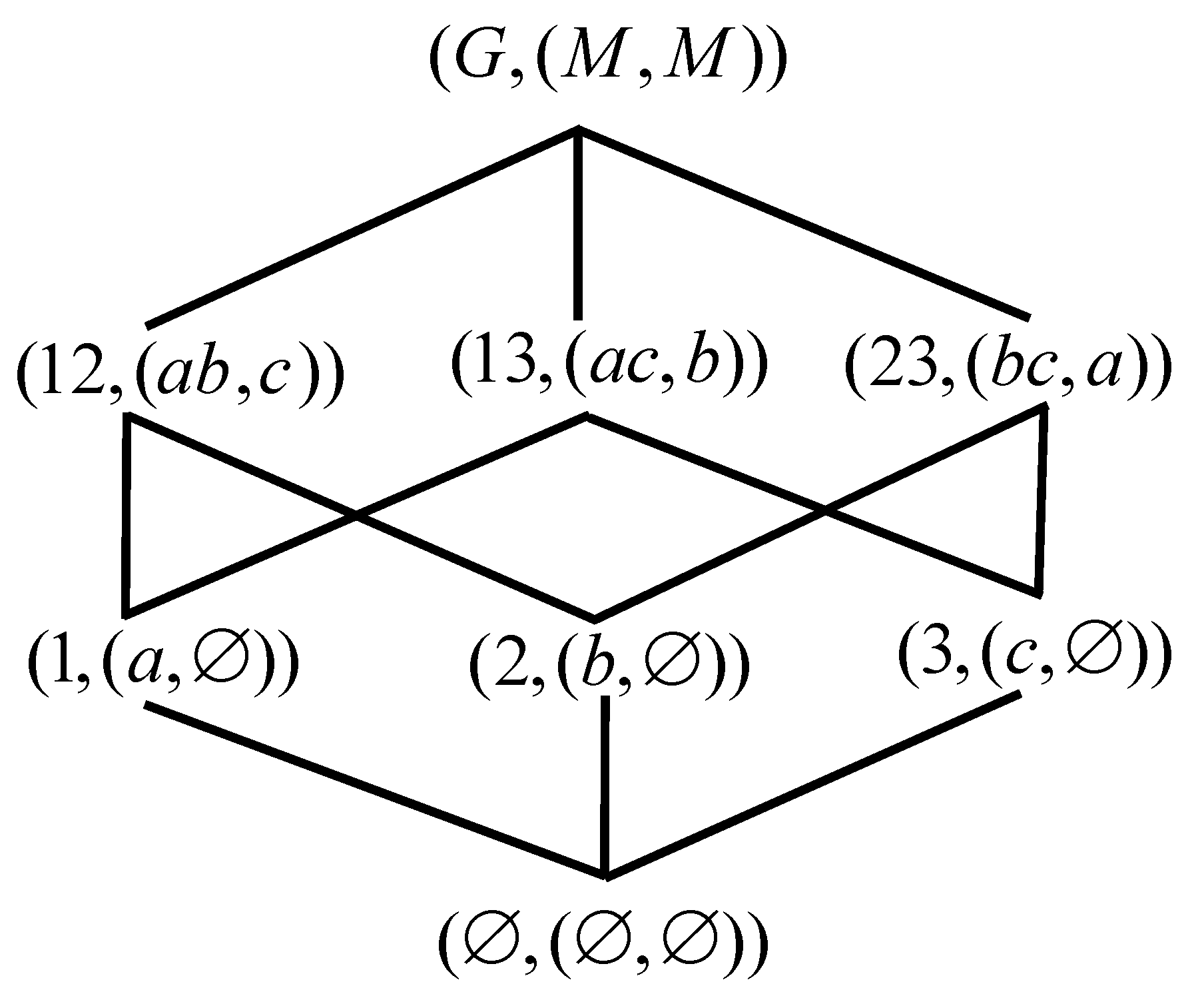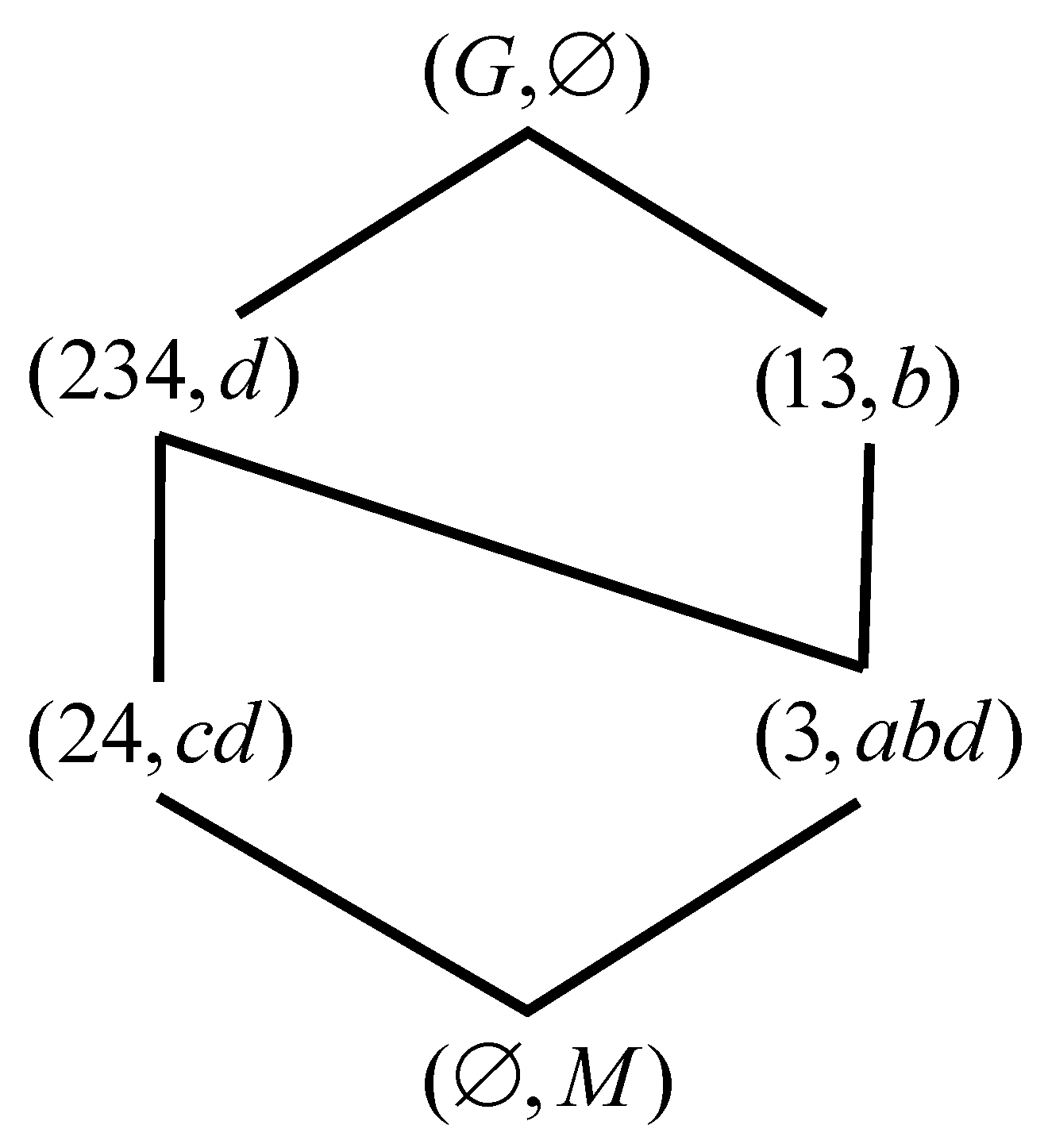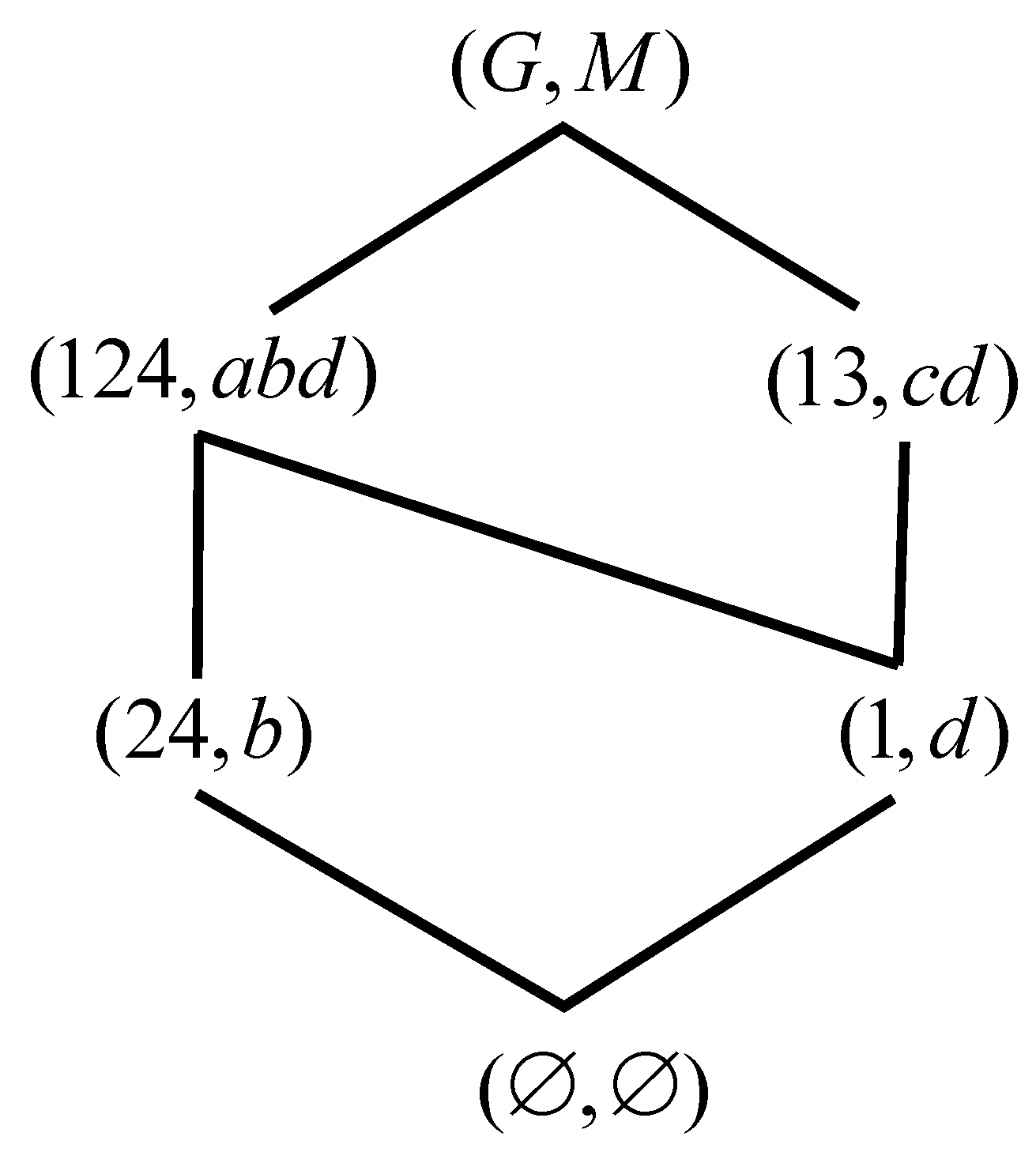1. Introduction
In order to find an application carrier for lattice, FCA was proposed by Wille in 1982 [
1,
2]. It studies the hierarchical structures (that is, concept lattice) which is induced by a binary relation of objects and attributes. In recent years, FCA becomes an helpfull tool for data processing and knowledge discovery [
3,
4,
5,
6,
7,
8,
9,
10]. For adapting to different data analysis, Wang et al. studied the AFS concept lattice [
11]. Ma et al. proposed the variable threshold concept lattice [
12]. Guo et al. provided the power concept lattice [
13]. Li et al. gave the approximate concept lattice [
14] based on incomplete data. Düntsch and Gediga [
15] and Yao [
16] proposed the property oriented concept the lattice and object oriented concept lattice, respectively, and so on.
Recently, an outline of three-way decision was proposed [
17]. Conflict analysis and FCA has been widely developed based on three-way decision. Three-way conflict analysis was proposed and studied [
18,
19,
20]. In addition, 3WCA was firstly introduced by Qi, Wei and Yao in 2014 [
21]. Then, 3WCA has become one of the helpful research problems. Firstly, Qi et al. gave the connections between the three-way concept lattice and classical concept lattice [
22]. In terms of lattice building, Qian et al. proposed the method based formal context from the perspective of context [
23]. Later, Yang et al. in 2020 proposed the method based on the composite of classical lattices from the perspective of lattice [
24]. In terms of attribute reduction, Ren et al studies the reduction theory of three-way concept lattices from the perspectives of preserving intersection (Union) irreducible elements, preserving granular and preserving lattice structure, respectively [
25].
In addition, inspired by 3WCA, some new three-way concept lattice models are proposed. Firstly, OEOL was proposed by Wei and Qian based on the ideal of locally completely (no-) possessing [
26]. Later, Qian et al. discussed them more comprehensively and detailedly in [
27]. Li et al. put forward three-way cognitive concepts based on cognitive theory and studied them through multi granularity method [
28]. Conflict analysis model was proposed based on 3WCA by Zhi et al. [
29]. Mao and Cheng proposed the three-way rough semiconcept in 2021 [
30]. Meanwhile, intuitionistic fuzzy three-way formal concept analysis were studied by using attribute correlation degree in 2021 [
31].
However, 3WCA are much more complex than FCA because of the large amount of information the three-way concept lattices carried. So, this brings us a lot of trouble in dealing with them. In addition, FCA has improved maturely. Therefore, it is a good idea to deal with the problems of 3WCA by using the related methods of FCA. Along the above research ideas, Yang et al. used the composite of classical lattices to construct the three-way concept lattices [
24]. Long et al. studied attribute-induced three-way concept lattice in incomplete fuzzy formal context by double threshold construction method [
32]. Chen et al. used unlabelled text mining methods to study object-induced three-way concept lattice [
33]. From the perspective of formal context characteristics, Qian et al. gave a kind of attribute characteristics, that is
, which is called the dual intersectable attribute (later, we call it the type I-dual intersectable attribute. The corresponding formal context is called type I-dual intersectable formal context). Furthermore, they studied the isomorphic relation between concept lattice and three-way concept lattices based on the dual intersectable formal context [
34].
The literature [
34] tells us that
means original information describes supplementary information. Inspired by it, we consider another attribute feature by using supplementary information to describe original information and then we investigate the isomorphism among concept lattices, especially the relationship between concept lattice and OEOL in this paper.
The rest of the paper is organized as follows.
Section 2 reviewes some notions briefly. In
Section 3, we propose the type II-dual intersectable formal context and investigate the relations among some concept lattices including concept lattice, the object oriented concept lattice and OEOL when the formal context is the type II-dual intersectable context. In
Section 4, the inverse proposition of related conclusions in
Section 3 are given. In addition, several theorems and examples are given. Finally, the summary is given by using a diagram in
Section 5.
3. The Relations between Kinds of Concept Lattices and OEOL
In this section, the relations between kinds of concept lattice and OEOL based on some context are explored firstly.
For the convenience of description, we give the following symbols:
The set consisting of all extents of the formal concepts, the set of all extents of the object oriented concepts and the family of all extents of the three-way object oriented conceptsis are, respectively, denoted by , and .
3.1. The Type II-Dual Intersection Formal Context
In fact, Qian et al. studied the isomorphic relation between concept lattice and three-way concept lattices. In addition, then they proposed the dual intersectable context [
34]. Similarly, we propose another form of dual feature of attributes in this subsection. In order to distinguish, we call the original dual feature of attributes as type I.
Definition 6. Let a formal context be , . If there are some which satisfies , then a is called a type II-dual intersection attribute.
The attribute features described in Definition 6 means that original information are described supplementary information. Let’s explain it with the following example.
Example 4. A formal context is represented in Table 2. By definition of *, we can compute that , , so we get . It’s easy for us to verify that a is a type II-dual intersection attribute by Definition 6. Next, we describe the features of formal context based on the above attribute features. In addition, we explain it by examples.
Definition 7. Let a formal context be . If a is type II-dual intersection attribute for any , then is called a attribute-induced type II-dual intersection formal context.
Example 5. We can calculate the following results in turn from Table 2. , , , so we get ).
, , , so we get ).
, , , so we get ).
, , so we get .
, , so we get .
It’s easy for us to verify is a attribute-induced type II-dual intersection formal context by Definition 7.
Let’s use a theorem to illustrate the relationship between type I-dual intersection formal context and type II-dual intersection formal context.
Theorem 1. Let be a formal context. is a type II-dual intersection formal context if and only if is a type I-dual intersection formal context, where .
Proof. Since we get . In the same way, . Therefore, when is a type II-dual intersection formal context, we obtain for any a by Definition 7. And then is equivalent to . So we get is a type I-dual intersection formal context. vice versa. □
By the proof of Theorem 1, we can easily draw the relationship between type I and type II: (1) a is a type II-dual intersection attribute of if and only if a is a type I-dual intersection attribute of ; (2) is a type II-dual intersection formal context if and only if is a type I-dual intersection formal context.
3.2. The Relationship between Kinds of Concept Lattices and OEOL Based on the Type II-Dual Intersection Context
In the subsection, we will study the relationship among kinds of concept lattices based on the type II-dual intersection context. Firstly, the conclusions about the object oriented concept lattices based on the type II-dual intersection context are discussed.
Theorem 2. Let a formal context be . If is a type II-dual intersection formal context, then .
Proof. For any , we get by the property of operators . And . Similarly, we can get . Since is a type II-dual intersection formal context, we can get . Thus, we can get by De Morgan’s law. That is, . In addition, we know . So, we know by the property of operators ◊. For any , we can get . Thus, by the property of operators ◊. Therefore, . □
Combing Theorem 1 and Theorem 2, we can easily obtain the following conclusion.
Theorem 3. Let be a formal context. If is both a type I-dual intersection formal context and a type II-dual intersection formal context, then .
Theorem 4. Let a formal context be . If is a type II-dual intersection formal context, then and are isomorphic.
Proof. For any , we get and by Definition 5. Since is a type II-dual intersection formal context, we can obtain by Theorem 2. And then . Thus, . Therefore, . In addition, for any , we can easily get by the properties of □ and ◊. That is, . In summary, . Therefore, and are isomorphic. □
Next, the following conclusions about concept lattices based on the type II-dual intersection context are drawn.
Theorem 5. Let a formal context be . If is both a type I-dual intersection formal context and a type II-dual intersection formal context, then .
Proof. Since is a type I-dual intersection formal context, we get that there are some which satisfies , for any . That is , for any . Thus, by the property of operators. Therefore, . Similarly, since is also a type II-dual intersection formal context, we get . So . □
Through Theorem 5, we can easily establish the following conclusion by constructing isomorphic mapping.
Theorem 6. Let a formal context be . If is both a type I-dual intersection formal context and a type II-dual intersection formal context, then and are isomorphic.
Proof. Let , for any , . So we can easily prove that it’s an isomorphic mapping. Thus, we obtain and are isomorphic. □
Let’s illustrate that the inverse proposition of Theorem 6 does not hold by an example.
Example 6. A formal context is shown in Table 3. Figure 4 and Figure 5 are and , respectively. We can obtain , , , , from Table 3. In addition, it’s easy for us to verify d is not a type type I-dual intersection attribute, Thus, the formal context of Table 3 is not a type I-dual intersection formal context. But we can get and are isomorphic from Figure 4 and Figure 5. In fact, we can summarily compute , , , , from Table 3. And it’s easy for us to verify a is not a type II-dual intersection attribute by Definition 6. Thus, the formal context of Table 3 is not a type II-dual intersection formal context by Definition 7. Theorem 7. Let a formal context be . If is a type II-dual intersection context, then and are anti isomorphic.
Proof. Let , for any , . So let’s prove that it’s an anti isomorphic mapping. In fact, we know and are anti isomorphic. And then through Theorem 4 and transitive properties of isomorphism, we can easily get is an anti isomorphic mapping. □
4. The Characteristics of Formal Context Based on the Relationship among Kinds of Concept Lattices
Next, we mainly discuss the inverse proposition of the theorems in
Section 3.
Theorem 8. Let a formal context be . If , then is a type II-dual intersection formal context.
Proof. For any , we get by the property of operators *. In addition, since , we can obtain . So we can have . In addition, then we get by Definition 1. Thus, we can get a is a type II-dual intersection attribute by Definition 6. By the arbitrariness of a, we get is a type II-dual intersection formal context by Definition 7. □
Theorem 9. Let a formal context be . If , then is a type I-dual intersection formal context.
Proof. For any , we get by the property of operators ◊. In addition, since , we can obtain . So we can get . In addition, . Similarly, we can get . by Definition 1. So we get by De Morgan’s law. And then we get is a type I-dual intersection formal by the arbitrariness of a context. □
Theorem 10. If , then is both a type I-dual intersection formal context and a type II-dual intersection formal context.
Proof. Since , we can get and . When , we can obtain is a type II-dual intersection formal context by Theorem 8. In addition, When , we can obtain is a type II-dual intersection formal context by Theorem 7. In addition, when is a type II-dual intersection formal context, we can get is a type I-dual intersection formal context by Theorem 1. In summary, we get is both a type I-dual intersection formal context and a type II-dual intersection formal context. □
Similarly to Theorem 10, we have the following conclusion which is obviously true by combining with Theorem 9.
Theorem 11. Let a formal context be . If , then is both a type I-dual intersection formal context and a type II-dual intersection formal context.
Let a formal context be . If and are anti-isomorphic, then is a type I-dual intersection context. This is not necessarily true. See the following example for details.
Example 7. The formal context is shown in Table 3. Its the object oriented concept lattice is shown by Figure 6. We can easily obtain and are anti-isomorphic. But according to Example 6, we know is not a type I-dual intersection context and is not also a type II-dual intersection context. Next, let’s study the characteristics of formal context when two-way lattices and three-way lattice are isomorphic.
Theorem 12. Let a formal context be . If and are isomorphic, then is a type II-dual intersection formal context.
Proof. Suppose , we can get , . In addition, . So, , Thus, we can obtain by the definition of OEO-concept. Therefore, . Similarly, we can get . Since and are isomorphic, we can get . Thus, . Therefore, is a type II-dual intersection formal context by Theorem 11. □
Theorem 13. Let a formal context be . If and are anti-isomorphic, then is a type I-dual intersection formal context.
Proof. Suppose , we can get , . In addition, . So, , Thus, we can obtain . So, . Similarly, we can get .
Suppose , we define , for any , . So we can easily prove that it’s a reverse order isomorphic mapping. So, and are anti isomorphic. In addition, we know and are anti isomorphic. So we can obtain that and are isomorphic from the transitivity of isomorphism.
And we know . Thus, . Combining with , we can get . Therefore, is a type II-dual intersection formal context by Theorem 8. In addition, when is a type II-dual intersection formal context, we can get is a type I-dual intersection formal context by Theorem 1. □













